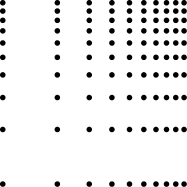The log grid and its measurements (ID: LGM230517)
What we call the log grid is simply the image of the grid \(\mathbb{Z}_+^d\) under a logarithm, with the only assumption that its basis is a positive integer. So the definition is simply \(l\mathbb{Z}_+^d := \lbrace \log(z) | \mathbb{Z}_+^d \rbrace\) and a simple consequence from the construction is that $(0,…,0)\in l\mathbb{Z}_+^d$. To start, we consider its relation the underlying grid \(\mathbb{Z}_+^d\). Note to this end, that two neighbors in \(\mathbb{Z}_+^d\) always have distance $1$ in the \(L^1\) norm. This pertains even for grid points with arbitrary large entries since they differ in at most one coordinate $x$ and the difference is $1$. For \(l\mathbb{Z}_+^d\) this difference becomes \(\log(x+1)-\log(x) = \log(1+x^{-1})\to 0\) as $x\to\infty$. Note that this limit always implies going along the same “horizontal” or “vertical” line to employ the illustrative terms from $2$ dimensions for which we present the following figure showin \(l\mathbb{Z}_+^d\).

Questions which could be of interest are the same as in differential geometry in terms of as embedded geometry in \(\mathbb{R}_+^d\) or intrinsic geometry and discrete interpretations of curvature relativ to the “flat” \(\mathbb{Z}_+^d\). We will focus on first step questions which concern the embedded geometry and the comparison with scalings and translations of \(\mathbb{Z}_+^d\) of the form \(\alpha\cdot\mathbb{Z}_+^d +\beta\) for \(\alpha > 0\), \(\beta \in\mathbb{R}_*^d\) with \(\exists i,j\) such that \(\beta_i\neq \beta_j\) or \(\beta=(0,...,0)\). In this regard we want to answer the following questions:
- Characterize the values \(\alpha\) such that \(\mathcal{Z}_d = l\mathbb{Z}_+^d \cap (\alpha\cdot\mathbb{Z}_+^d+\beta)\) has size $n=2,3,4,…$.
- Find the symmetries of \(\mathcal{Z}_d\) as structure embedded in \(\mathbb{R}_+^d\).
In \(2\) dimensions, we see by the picture and \(\beta=0\), that the choices \(\alpha=\log(k)\) and \(\alpha=\log(1+k^{-1})\) for \(k\in\mathbb{N}\) give always \(| \mathcal{Z}_d |=4\) and \(\mathcal{Z}_d\) is symmetric around the main axis \(\lbrace (l,l) | l\in\mathbb{N}\rbrace.\) Other solutions with \(\beta \neq (0,...,0)\) only have size $2$ and do not bear any particular symmetry aside from the fact that they lie on the same horizontal or vertical line.
